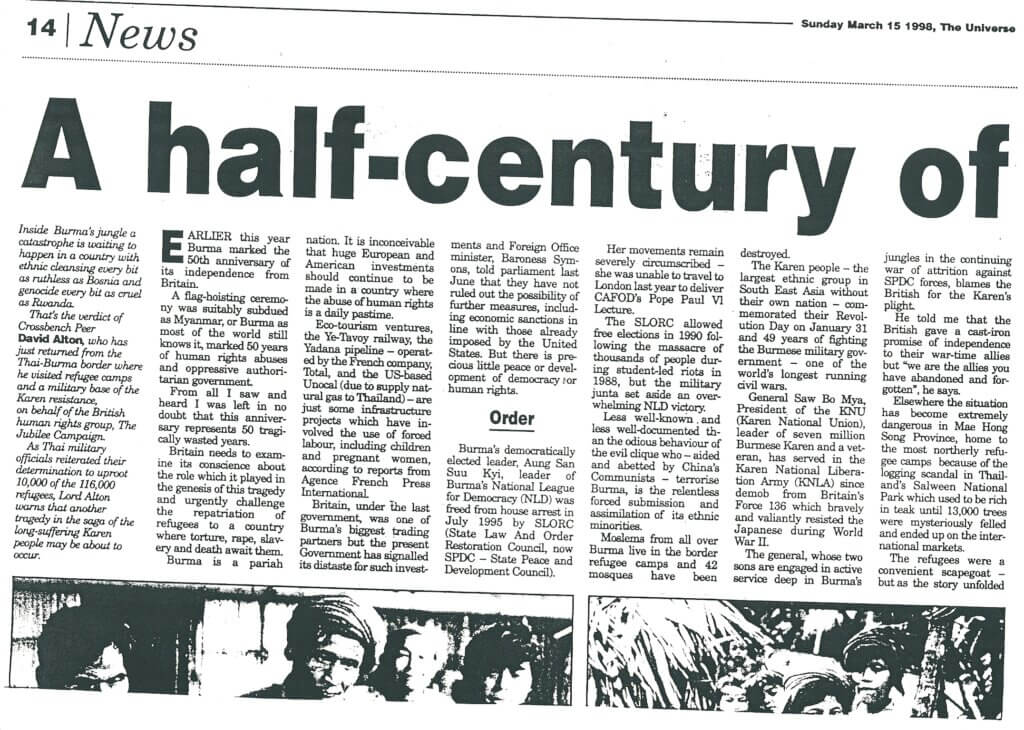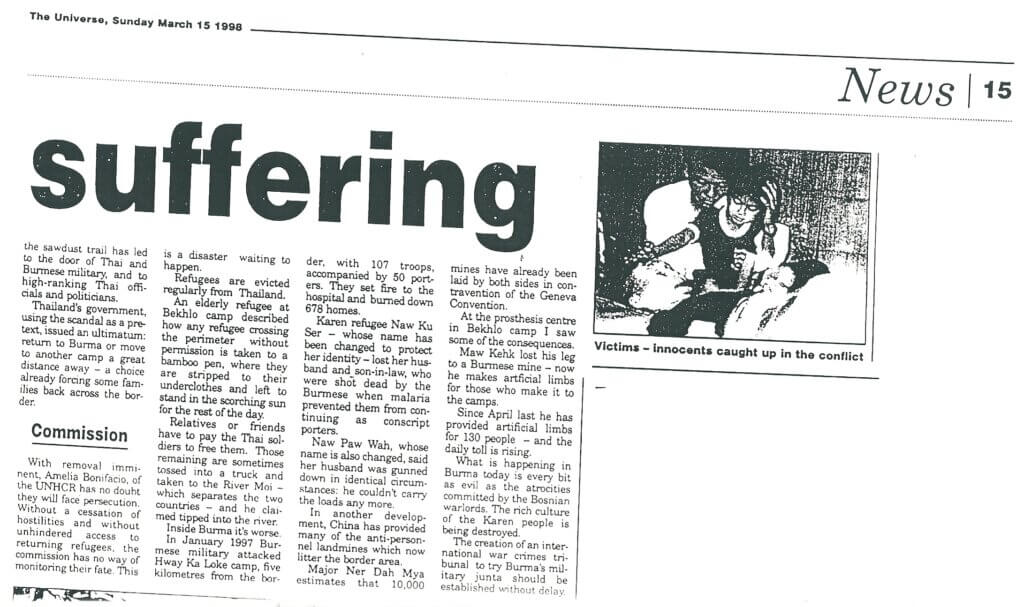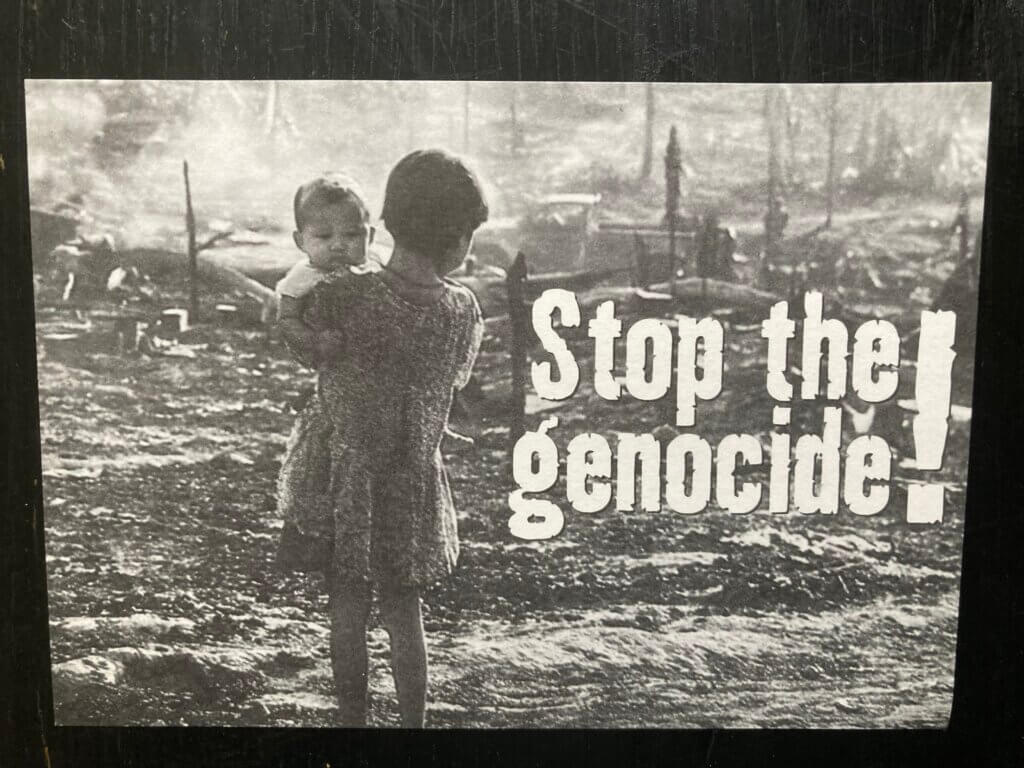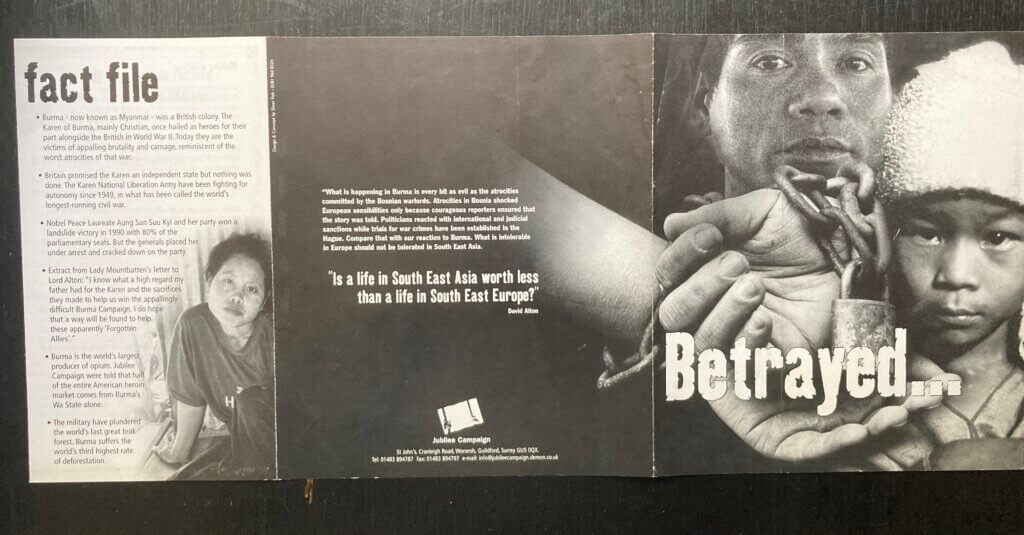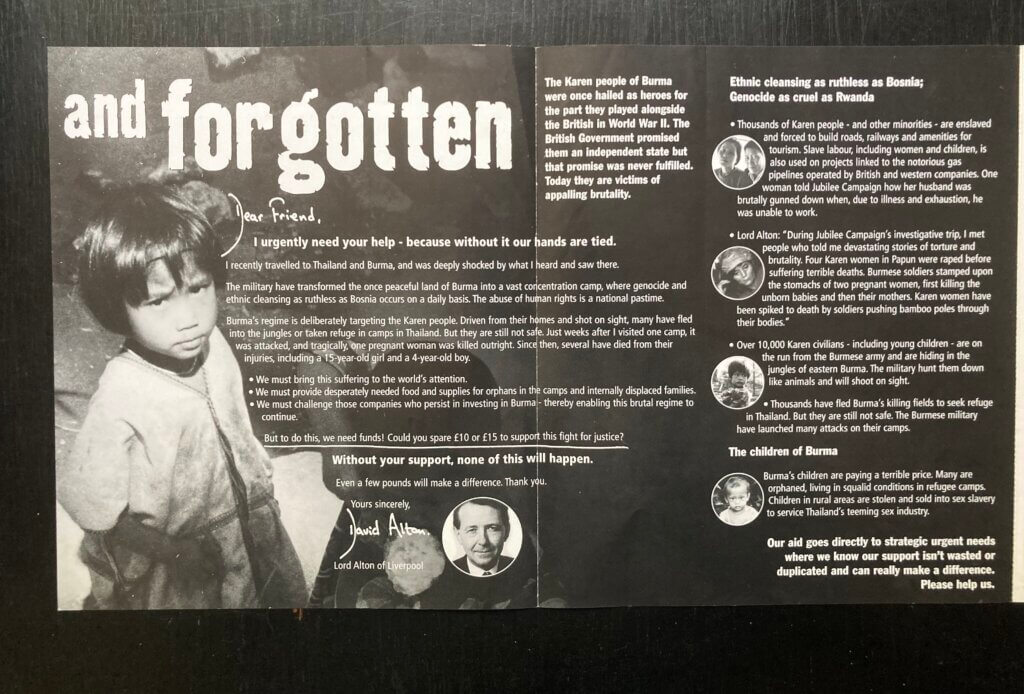Karen Human Rights Group Highlight The Lethal Danger of Landmines in Southeast Burma, where the use of landmines by the Junta and other armed actors has proliferated (scroll down).
First, a recollection of my reports from illegal visits into the Karen State during the previous military dictatorship.
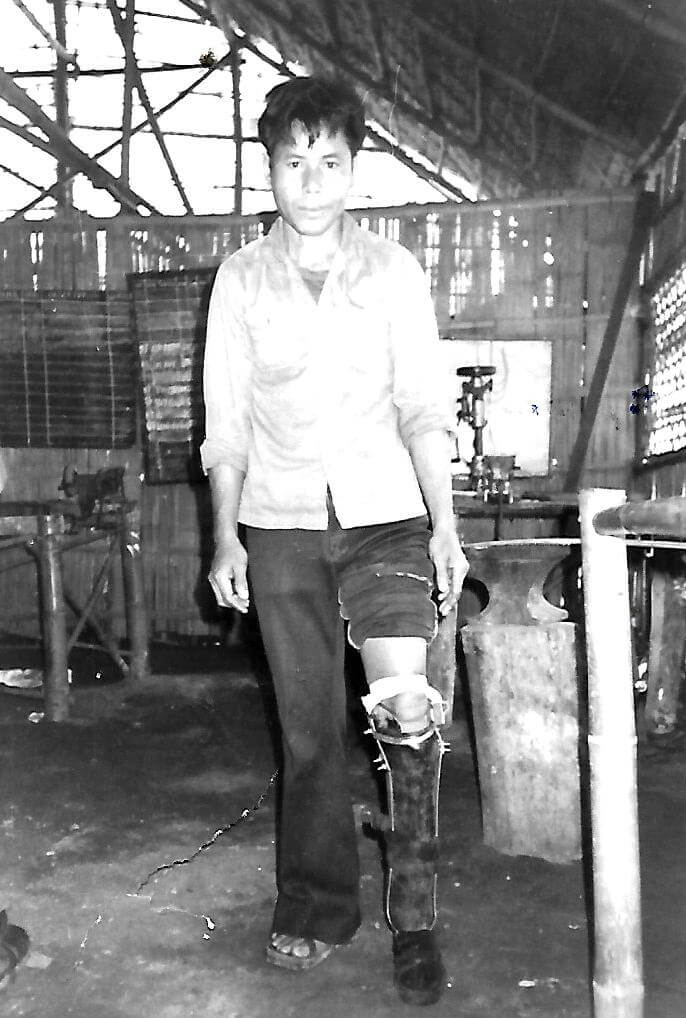
Picture I took in the Karen State in the over twenty years ago of a victim of landmines. Shocking that this is happening all over again.
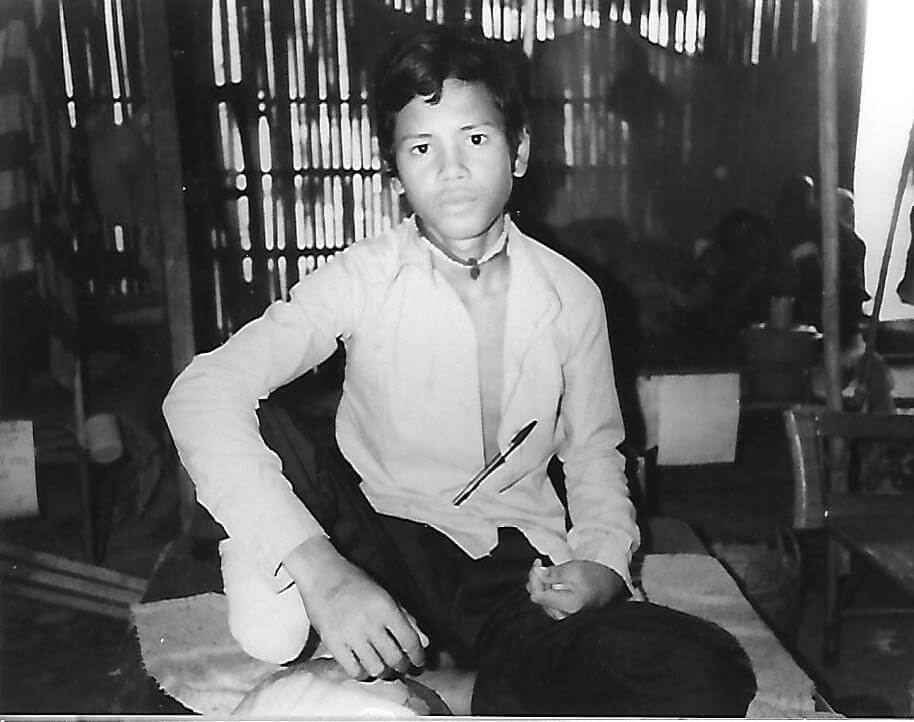
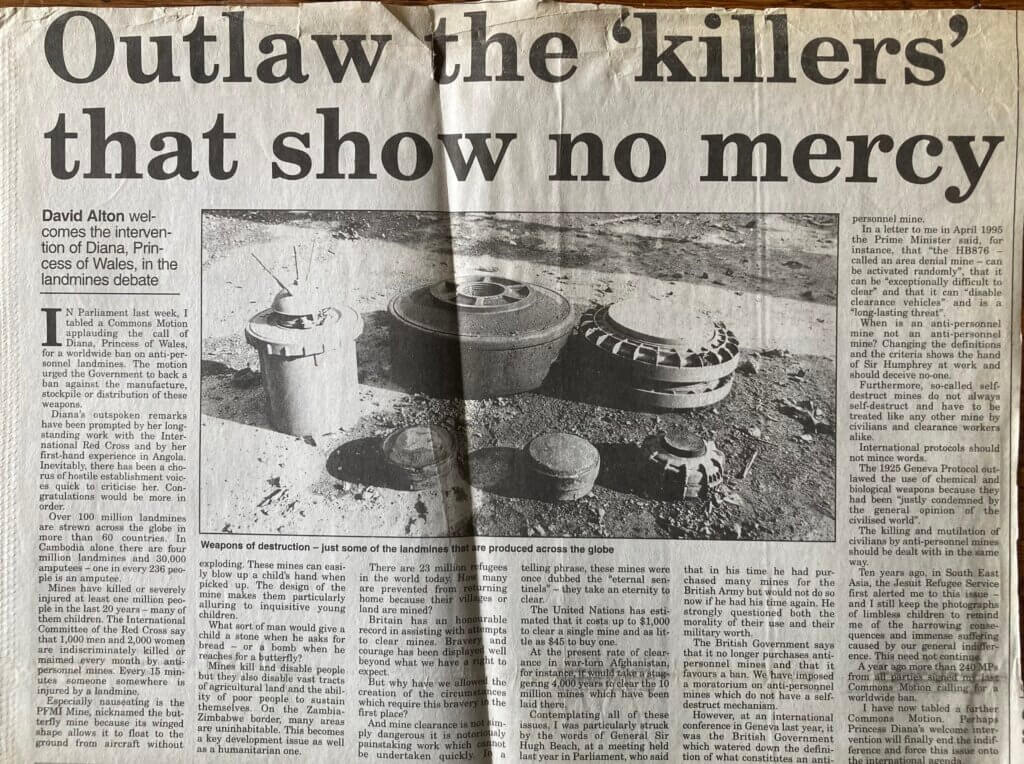
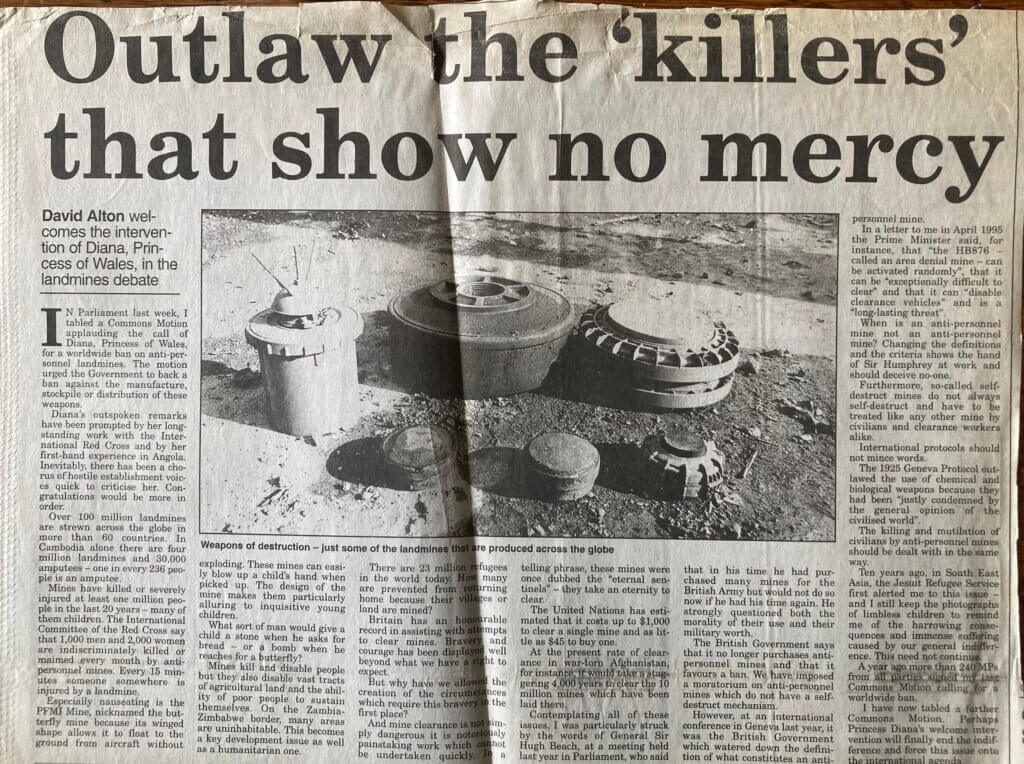
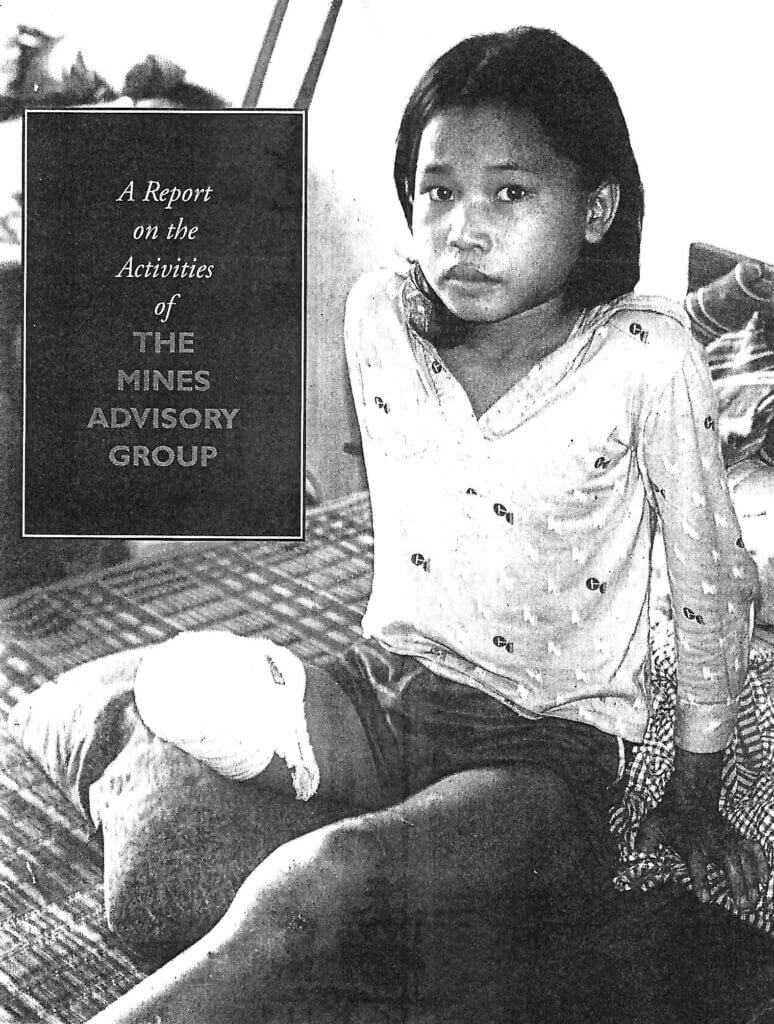
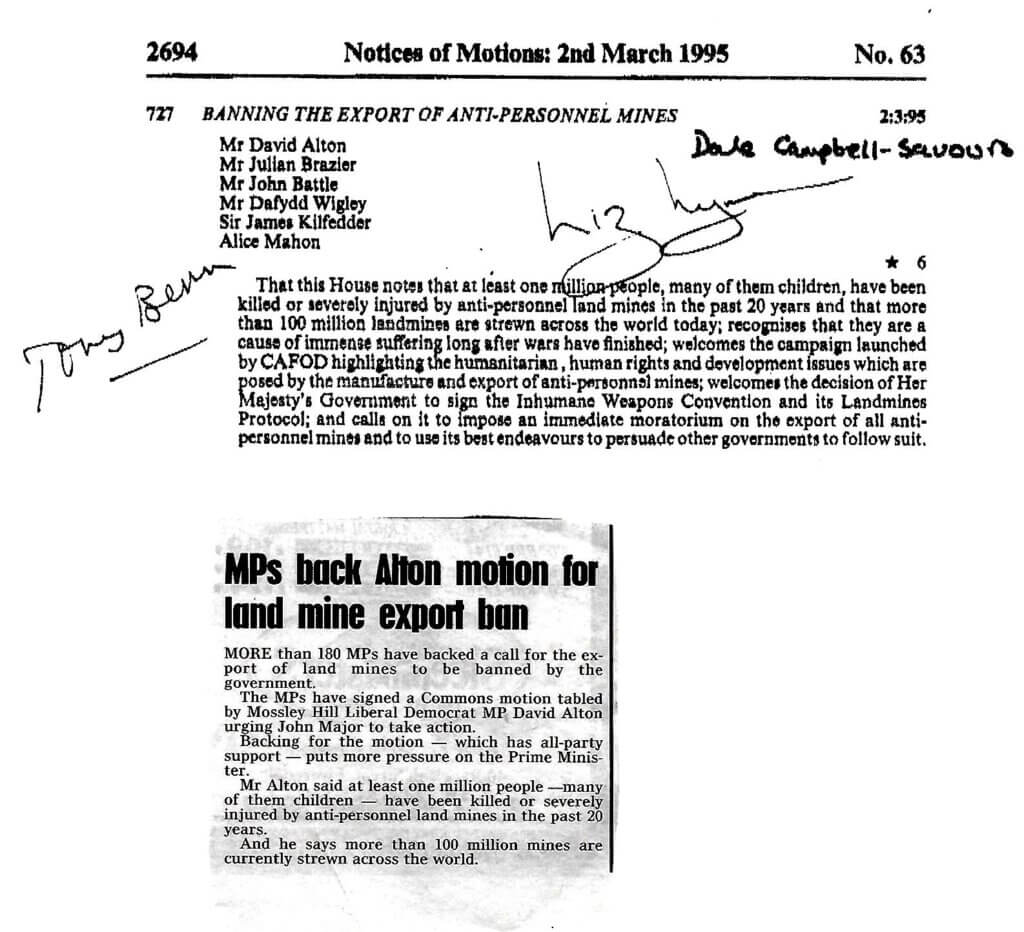
| “Right now, the SAC has planted landmines near villagers’ plantations and farms and we [civilians] don’t know where [exactly]. When there are no explosions, then things will be in peace. The SAC should not act this way. The SAC labels […] civilians as soldiers.” Testimony of a villager from Noh T’Kaw Township, Dooplaya District. |
| Introduction Since the 2021 coup and the subsequent intensification of armed conflict, the use of landmines has proliferated in Southeast Burma (Myanmar). Landmines are used by not only the State Administration Council (SAC), but all armed actors in Southeast Burma, to both protect territory and attack opponents. Villagers are severely impacted by this proliferation and expansion of landmine use in the ongoing conflict and the SAC has been increasingly targeting civilians directly with these indiscriminate weapons. In locally-defined Karen State, this is causing civilian deaths and injuries and affecting the lives and livelihoods of villagers. This briefing paper presents incidents of landmine explosions in civilian areas since the 2021 coup and examines the impacts and needs of the affected communities. The first section provides a brief overview of the context of landmine contamination in Southeast Burma. Secondly, evidence of landmine casualties and the impact on local communities, as well as the challenges and risks that villagers face, are presented. Thirdly, a security and legal analysis of the situation is conducted, as well as a set of policy recommendations provided for local and international stakeholders. 2. Contextual overview Burma is the only country in the world where the ‘state security forces’ actively use landmines within its territory against their own civilian population. Burma is not a party to the 1997 Mine Ban Treaty and it is listed as one of the 12 remaining landmine producers by the International Campaign to Ban Landmines (ICBL). According to the United Nations’ Myanmar Information Management Unit, all states and divisions, as defined by the Burma government, have been contaminated by landmines over the past decades. In the decades of conflict between the Burma Army and armed resistance groups around the country, landmines have long been used to secure contested territory. However, the Burma Army has directly and actively targeted civilians with landmines as part of the “four cuts” strategy which aims to destroy links between insurgents, their families, and local villagers by cutting off food, funds, intelligence, and recruits to ethnic armed groups. To prevent resistance forces from knowing where landmines are planted, the Burma Army has often deliberately withheld this information from civilians. Landmines remain in place from the decades of conflict, and the Burma Army is actively planting new landmines amid the intensified conflict as they seek to affirm nationwide military control following the 2021 coup. The current armed conflict has created immense difficulties preventing mine clearance programs from being implemented. Karen State has a high level of landmine contamination. Human rights abuses related to landmines are not a new issue; landmines and unexploded ordnance (UXOs) have posed a persistent threat to villagers throughout the decades of conflict. With new landmines being extensively planted across Southeast Burma by both the SAC and armed resistance groups, there is now a combined danger of old and new landmines. These new landmines are being planted in areas unavoidable to villagers and they are increasingly not only accidental victims but are often targeted with landmines by the SAC and its affiliated armed groups. According to Article 2.2 from the 1997 Mine Ban Treaty, a mine is defined as “a munition designed to be placed under, on or near the ground or other surface area and to be exploded by the presence, proximity or contact of a person or a vehicle.” According to KHRG documentation, the SAC primarily uses factory-made mines whereas the Karen National Liberation Army (KNLA), mostly use handmade mines, improvised explosive devices (IEDs) and anti-vehicle tripwire bombs. KNLA handmade mines are not as powerful as SAC factory-made mines and, usually, factory-made can remain active for decades, whereas handmade mines usually have a lifespan of six months. Nonetheless, both pose a significant threat to local communities. The KNLA sometimes informs local villagers where soldiers plant landmines, but often not adequately. The SAC usually fails to inform local villagers where they plant landmines, or purposely conceals their location, presenting immense danger when this occurs in civilian areas. |
 |
| 3. Factual summary: Landmine incidents and impacts on local communities This chapter presents incidents of anti-personnel landmine explosions and their impacts on local communities in Southeast Burma since the 2021 coup. Since February 2021, KHRG has received reports from across all seven KHRG operational districts containing evidence of 64 landmine incidents involving villagers, which resulted in at least 21 deaths and 60 people injured, including children. These reports were collected by local community members trained by KHRG to document the human rights situation in Southeast Burma. Landmine incidents are often underreported because of security concerns preventing researchers from travelling to certain areas and victims/survivors lacking knowledge of how to report incidents. Therefore, the actual number of casualties resulting from landmine incidents is expected to be much higher. Although both the SAC and armed resistance groups use landmines for military purposes −self-protection or territory defence− the main victims of landmine explosions are villagers as landmines are planted in villages, plantations and roads. From analysis of this information, some trends in landmine incidents in Karen State are explored: landmines are commonly stepped on when villagers are engaging in essential livelihood activities, landmines are harming villagers often in the aftermath of fighting between armed groups, and there is inadequate warning about landmine contamination. The impacts of landmine incidents are also presented, including coping with deaths and injuries, livestock being harmed, and restricted freedom of movement. I. Trends of landmine incidents in locally-defined Karen State since the 2021 coup a) Villagers stepped on landmines while engaging in livelihood activities The majority of landmine-related incidents documented by KHRG since the 2021 military coup involved villagers who stepped on landmines while engaging in their livelihood activities. These landmines were planted near or in villagers’ plantations and farms. Farming and crop plantations are the main source of livelihood for most rural communities in locally-defined Karen State and these landmines are unwittingly triggered when villagers are working, usually unaware of the contamination. For example, on February 16th 2023, two villagers, Saw A— and Naw B— (a father and his daughter), from C—, Ma Kah Heh village tract, Bu Tho Township, Mu Traw District, went out to cut bamboo in order to fence their farmlands. Saw A— stepped on a landmine and sustained injuries on his right leg, that later had to be amputated. Naw B—, also stepped on a landmine when she went to help her father. Her legs were seriously injured by the landmine explosion, resulting in a double amputation. Residents of A— village believe that these landmines were planted by KNLA soldiers from Battalion #15 because the KNLA had informed some villagers about the planting of landmines in the surrounding area one week beforehand. Although villagers are sometimes aware of landmine contamination, they often have no choice but to pass through contaminated areas to carry out essential livelihood activities. For example, on June 20th 2021, Saw D—, a 32-year-old villager from E— village, Aur’Naung Pat Kan Ywar village tract, Hpapun Town, Dwe Lo Township, Mu Traw District, stepped on a landmine while he was returning home from his fields in the hills. Due to the injuries he sustained from the landmine explosion, doctors at Hpa-an Hospital had to amputate his right leg. His left leg was also broken by the explosion, and the landmine shrapnel injured his scrotum. He had stepped on a landmine on one of the paths in the forest, where there were no signs indicating landmine danger. His family and local villagers are unaware of who planted the landmines in this area, however they believe that they were planted in 2021. The local authorities had previously informed villagers about the contamination of landmines and told villagers not to go to prohibited areas. However, the victim’s sister explained that her brother cannot avoid going to the forest due to the need to sustain his family’s livelihood. Similarly, Naw F—, a villager from G— village, Kheh Kah Hkoh village tract, Ler Doh Township, Kler Lwee Htoo District, described. We are now afraid to use that road because of the two [landmine] incidents that happened in the same area. We do not dare to go to the areas surrounding the village. We are so worried. Even though we were told not to use the prohibited road, we need to go to town to buy goods. If we don’t, we will have nothing left to eat. […] The villagers living in this village buy their food in town. How can we survive without being able to travel to buy food?” b) Villagers stepped on landmines left behind after fighting Landmines are actively used in the conflict areas of Southeast Burma. As a result, some villagers have stepped on landmines planted after fighting between the SAC and armed resistance groups. For instance, on November 26th 2022, fighting broke out in H— village, Than Moe Taung village tract, Daw Hpa Hkoh Township, Taw Oo District, between SAC soldiers based in H— village and the combined forces of the People’s Defence Force (PDF) and Northern Than Taung Peace Group (Aye Chan Yay A’pweh). Following the clash, SAC soldiers repaired their army camp and planted more landmines in the area, including in locations further away from their camp and on villagers’ land. Two or three days after the fighting, SAC soldiers notified villagers not to use Than Moe Taung Road and restricted access to it because of landmines planted there. On January 13th 2023, Daw I—, a 68-year-old female villager from H— village, stepped on a landmine on Than Moe Taung Road when she was returning from collecting wood nearby. Her left leg below the knee was blown off and she sustained severe injuries to her right leg, left arm and face. Daw I— died before other villagers could arrive to help. Although local villagers stopped using the road, the victim’s son believes that his mother might have forgotten the warning and restriction due to her advanced age. |
  |
| These photos were taken on January 13th 2023 in H— village, Than Moe Taung village tract, Daw Hpa Hkoh Township, Taw Oo District. They show the body of Daw I—, a 68-year-old female villager after she stepped on a landmine on January 13th 2023 near H— village. The landmine was planted by SAC troops following armed clashes in the area. [Photos: Local villager] |
| On other occasions, the SAC and its allies have purposely planted landmines inside villages to prevent civilians from returning to certain areas or near infrastructure, including medical clinics and religious buildings. For instance, on November 16th 2021, the junta-affiliated Border Guard Force (BGF) Company #3 entered a village located in Pwa Gaw village tract, Hpa-an Township, Doo Tha Htoo District, and destroyed the medical clinic buildings and looted materials. They threatened local villagers not to enter the clinic compound anymore. Villagers assume the BGF planted a landmine in the clinic and did not feel safe going back. c) Inadequate warnings and a lack of mine awareness training The SAC fails to adequately mark contaminated areas with signposting or inform villagers in Southeast Burma of the location of landmines they have planted in the area. Armed resistance groups usually inform villagers orally, however, these warnings are also often inadequate. The information villagers receive is incomplete and the precise location of landmines remains unknown and unmarked. For example, on June 29th 2021, Saw J—, a 10-year-old villager from K— village, Ma Htaw village tract, Dwe Lo Township, Mu Traw District, stepped on a tripwire that detonated a landmine while he was returning home from L— village, where he had gone to retrieve a box that contained clothes and books. From the explosion, the victim sustained injuries to his face, neck, leg and abdomen. After the incident, he was sent to the SAC military’s Tactical Battalion #340 hospital situated in Hpapun Town to receive treatment. The medical staff were able to remove all of the shrapnel that hit his body. The victim was discharged from the hospital on July 27th 2021. His injuries took many months to heal fully. Before the incident, villagers were informed by the local KNU authorities that there was landmine contamination in the area. They were told to remain only on the road and not to wander anywhere to the sides of the road. According to the victim’s brother, these landmines were planted in May 2021 by the local ethnic armed groups. Even though Mine Risk Awareness training was provided to the villagers in 2020, the family of Saw J— was unable to attend that training; they only received pamphlets containing landmine awareness information. No one has previously been injured due to landmine explosions in K— village, and this was the first time that any landmine has exploded in or near the village. Despite the warnings from the local authorities not to go to places where there is landmine contamination, landmines planted near the road and surrounding areas pose a danger to local villagers nonetheless. Furthermore, there were no signs indicating where landmines have been planted in the vicinity of the village. |
   |
| These photos were taken on July 27th2021 in K— village, Ma Htaw villagetract, Dwe Lo Township, Mu Traw District after Saw J— was discharged from the hospital. The photosshow the injuries that he sustained from the explosion. The wounds took many months to heal fully. [Photos:Local villager] |
| This lack of information provided on landmine contamination contributes to a high rate of incidents. Many local communities also lack Mine Risk Awareness training so they may not recognise landmine tripwires or contaminated areas. For example, on October 20th 2022, M— , a villager from N— village, Maung Khee village tract, Kaw T’Ree Township, Dooplaya District accidentally triggered a tripwire landmine when he went to make charcoal beside an SAC military camp near the village. Local villagers assumed that the landmine has been set by the SAC. The victim was sent to Waw Lay Hospital, Waw Lay Town, Kaw T’Ree Township, Dooplaya District. No Mine Risk Awareness training had been provided in N— village. The victim does not have any relatives, so his neighbours and other villagers took care of him and supported him. No organisations financially supported him. M— was discharged from the hospital and has since recovered from his injuries. |
   |
| The photos were taken on October 20th 2022 and show the injuries a villager, M—, sustained from a tripwire landmine explosionin N— village, Maung Khee village tract, Kaw T’Ree Township, Dooplaya District, on the same day. The photos show the injuries to his left ear, leftleg and on his back. [Photo: Local villager] |
| According to KHRG documentation, many local communities in locally-defined Karen State do not receive Mine Risk Awareness training. Many villagers, especially children, have stepped on landmines because they were not aware of landmine contamination in their communities. One of the main challenges that villagers face in accessing mine awareness training in their communities is the ongoing armed conflict. These trainings are usually provided by local organisations such as Committee for Internally Displaced Karen People (CIDKP) and the Karen Teacher Working Group (KTWG) in all districts in locally-defined Karen State. Due to the conflict, it is difficult for local NGOs or other service providers to provide training for villagers in a safe place. As villagers always have to flee for their safety because of fighting, shelling and air strikes, villagers do not have time to receive training. The few organisations providing such training to local communities cannot reach all rural areas since some communities are in remote, hard-to-reach areas. Thousands of people are internally displaced in Karen State, often many times over, due to the ongoing armed conflict. When fleeing conflict, these internally displaced people (IDPs) must establish settlements in safe areas away from fighting and attack. Due to the high rate of landmine contamination across the state, rarely signposted, IDPs are at risk of landmine explosions when seeking safety in new areas. For instance, in early 2021, villagers from Xx— village, Meh Way village tract, Dwe Lo Township, Mu Traw District, had to flee fighting in their area and were displaced to a place in Bilin Township. As Ashin Xc—, a monk from Xx— village, explained, these villagers were deeply afraid of the landmine contamination in the area they fled to, as they had no way of knowing where the landmines were. Moreover, as landmines are often left behind after fighting, Ashin Xc— explained that IDPs were also afraid to return home to their villages because of new landmine contamination. II. Impacts of landmine incidents on local communities From KHRG reports, 21 villagers were killed and 60 villagers were injured, including children, by landmine explosions in Southeast Burma from February 2021 to November 2023. The survivors of these explosions are faced with many challenges, including coping with their physical injuries, the psychological impact of the traumatic incident, high medical costs, and livelihood challenges due to an inability to work or the loss of livestock from landmine explosions. This section will discuss the impacts on survivors of these landmine incidents and their families. a) Challenges facing landmine explosion by survivors and their family members For the survivors who lost limbs or sustained other serious injuries from landmine explosions, it severely disrupts their ability to work, particularly if they rely on manual labour for plantation farming. For example, on June 13th 2023, at around 2 pm, Saw O—, a 41-year-old man from P— village, Yaw Ku village tract, T’Nay Hsah Township, Hpa-an District, stepped on a landmine as he was going to the forest to collect some wild plants from a place near to a deserted Democratic Karen Buddhist Army (DKBA) army camp. His right foot was badly injured in the explosion. With his foot wounded, he travelled back alone from the jungle to a local villager’s tent. He was initially taken to the Q— hospital, but they could not provide adequate medical care there. Therefore, he was transferred to R— hospital, Pee T’Hka village tract, Ta Kreh Township, Hpa-an District, for medical treatment. He has now been discharged from the hospital however he was bedridden for months after the incident. Due to his injury, his inability to work threatens his family’s livelihood. |
 This photo was taken on June14th 2023, at R— hospital, Pee T’Hka village tract, Ta Kreh Township, Hpa-an District. It shows Saw O— receiving medical treatment in the hospital. [Photos:KHRG] This photo was taken on June14th 2023, at R— hospital, Pee T’Hka village tract, Ta Kreh Township, Hpa-an District. It shows Saw O— receiving medical treatment in the hospital. [Photos:KHRG] |
| Landmine survivors often face financial difficulties in getting treatment because of the high costs of medical care. For example, in October 2022, P—, a 36-year-old villager, from T— village, Htee Moh Pgha special area, K’Ser Doh Township, Mergui-Tavoy District, stepped on a landmine while he was going to drink water in someone’s house in his village. After the incident, the victim was sent to the general hospital in Tavoy City, Mergui-Tavoy District, where his right leg was amputated. While he was in the hospital, the SAC soldiers came and told him that this incident happened to him because he had a connection with the PDF. They did not take any responsibility for him. The cost of the hospital treatment was around 3,000,000 kyats [1,427 USD] meaning he needed to sell his car and motorcycle to afford the treatment. Due to the loss of his leg, it was difficult for him to work and support his family in daily life; he has three children. After being discharged from the hospital, he returned to his village and stayed with his relatives. The lack of adequate support is also prominent in cases of landmine explosion incidents. Some victims received some support from various stakeholders after the incident and villagers and close relatives sometimes help victims and their family members in terms of transportation and providing a little financial support. However, the support is not sufficient to meet their needs and all victims and their family members would benefit from long-term assistance programmes to help overcome the consequences of the incident on their ability to secure their livelihoods. b) Livestock killed and injured In 11 instances reported to KHRG, villagers’ livestock were killed and injured in landmine explosions. This also resulted in villagers’ livelihood challenges because animals such as cows and buffalos are used for farming and selling as a source of income. For example, on September 7th 2022, at about 11 am, a herd of cows belonging to U U— from V— village, Noh T’Kaw village tract, Noh T’Kaw Township, Dooplaya District, stepped on a landmine that was planted by SAC soldiers near Infantry Battalion (IB) #283 camp while the animals were roaming near the camp in V— village. Local villagers knew that the landmine was planted by SAC soldiers because the soldiers themselves told them so. A cow was killed and two others were severely injured by the landmine explosion. The severely injured cows were killed to be sold by their owner. Other incidents also happened in Hpa-an District. In January 2023, one of the cows owned by a villager named W— stepped on a landmine at A’Leh Bo Deh army camp (an SAC camp), Htee Wah Blaw village tract, T’Nay Hsah Township, Hpa-an District and broke a leg. Again, in January 2023, one of the cows of a villager named X— was killed by a landmine near Light Infantry Battalion (LIB) #356 located in Thin Gan Nyi Nuang military camp, Myawaddy Township, Hpa-an District. On January 24th 2023, three cows owned by a villager named Saw Y— were injured and two of his cows were killed by a tripwire mine explosion. This tripwire mine was set up by SAC LIB #357 beside Saw Z—’s farm. The SAC had planted landmines near the villagers’ farms but did not inform the villagers about them, and so the villagers released their cows unaware of the mine contamination. After the landmine explosions, the SAC soldiers asked to whom the cows belonged but no one answered because they knew the owner would be made to pay for the landmines that exploded. After these incidents, the SAC informed villagers from Aa— village and Ab— village that the cows’ owners would have to pay for landmines if their cows stepped on landmines again. The SAC soldiers also restricted some areas in Htee Wah Blaw village tract so villagers could not let their cows go and pasture there. c) Restricted freedom of movement Landmine contamination remains a barrier to villagers’ freedom of movement and is an obstacle to their pursuit of everyday livelihood activities. Villagers can often not safely travel to their farms and plantations, nor to towns to buy food and other essential supplies. For instance, on March 1st 2021, three villagers from G— village, Kheh Kah Hkoh village tract, Ler Doh Township, Kler Lwee Htoo District, were hit by a landmine explosion at Ac— place when they travelled to Ler Doh Town on two motorbikes to purchase goods for their shop. The incident place was three miles away from G— village. Saw Ad— and Naw Ae— died instantly and another villager sustained shrapnel injuries to his lips and legs. The injured villager immediately returned to the village and informed the victims’ families and the local authorities about the incident, after which they went to the incident location and brought back the bodies of the victims to the village. Local villagers have stopped going to certain areas and using the contaminated road since this incident. 4. Analysis: patterns of abuses and violations of international law Survivors and victims’ family members require long-term support in the aftermath of landmine incidents, including psychological care, medical rehabilitation and financial support to support livelihoods. The impact of landmine contamination on villagers across Southeast Burma is severe and increasing; their needs must be met by assistance from NGOs, community-based and civil society organisations (CBO/CSOs), and international organisations operating in Southeast Burma. The incidents presented in this briefing paper primarily involve landmines planted in farms, plantations or close to roads, which villagers unknowingly trigger while conducting their livelihood activities. Landmine incidents were also found to commonly occur as a direct result of fighting between armed groups in civilian areas: they are lain to control territory and not cleared in the aftermath of conflict, nor is adequate information of contamination spread among communities. Many children are victims of landmines in Southeast Burma; they are often even less aware of the location or dangers of contaminated areas than adults. A lack of mine awareness training in affected communities was a notable feature of many incidents. Villagers cannot avoid the risk of landmines when they lack knowledge of the location of contaminated areas and, as has been discussed, sometimes have to walk through known contaminated areas by necessity to secure their livelihoods. The use of landmines is an active and systematic strategy used by the SAC in Southeast Burma to attack both military and civilian targets. This is evident from the wealth of incidents documented in civilian areas, surrounding villages, on villagers’ land and plantations, and on roads used daily and the SAC’s often deliberate withholding of information on contaminated locations. Whilst armed resistance groups may use landmines to protect territory, including villages, from attack and sometimes inform villagers orally, civilians are nonetheless not adequately protected and contaminated areas are rarely signposted, which should be a minimum precaution. Landmines are always planted with intention to harm, and where civilians are targeted, severe violations of international law have taken place. Landmines do not distinguish between combatants and civilians in their victims, as anyone could trigger them. All parties of a conflict must ensure civilians are not targeted and are protected from their military operations. Landmine usage violates this principle of distinction between civilians and combatants, the basic tenet of international humanitarian law. The Burma government is one of few non-signatories to the Mine Ban Treaty (1997), which prohibits the use of anti-personnel landmines, and is an international pariah in using them against domestic civilians. As Matt Wells, Amnesty International’s Crisis Response Deputy Director, states, “at a time when the world has overwhelmingly banned these inherently indiscriminate weapons, the military has placed them in people’s yards, homes, and even stairwells, as well as around a church”. Landmine usage by the SAC is one of many examples of civilians being targeted without distinction from combatants. Villagers are not inadvertent victims, the use of indiscriminate weapons inside villages and in areas unavoidable to civilians shows deliberate targeting and clear motivation. As specified in Article 51 (5) of Additional Protocol I of the Convention on Certain Conventional Weapons (1980), weapons that cannot be exclusively directed towards military targets and thus cause indiscriminate damage, are prohibited. When lain in areas roamed by civilians, landmines do not discriminate their victims, and so are prohibited. Despite the Burma government’s non-acquiescence of this Convention, its terms are nonetheless applicable according to the ICRC commentary of rule 81: Restrictions on the Use of Landmines of customary international humanitarian law. State and non-state armed actors must adhere to the obligations outlined in the Convention to ‘take all feasible precautions to protect civilians from the effects of these weapons’, and to ‘take special precautionary measures such as marking and signposting of minefields’. The incidents presented in this briefing paper attest to the failure of all armed actors in Southeast Burma to do so. Whilst some armed groups may use landmines to protect areas from SAC attacks, including villages or bases, the incidents documented demonstrate their usage does not take sufficient precautions nor adequately inform villagers, and thus also fall short of customary laws to which they are also beholden to follow. Despite the Burma government not being a signatory of either the Mine Ban Treaty (1997) or the Convention on Certain Conventional Weapons (1980), customary international humanitarian law reaches beyond these Conventions; all armed actors must adhere to international standards, ensuring villagers in Southeast Burma are able to live in peace, with their right to life, livelihood, and security honoured and protected. Recommendations To international stakeholders and aid agencies: Acknowledge that the military junta is the reason for the current human rights and humanitarian crisis, and abstain from giving legitimacy to the junta, including by signing agreements with them and presenting them with credentials. Seek justice and hold the SAC accountable for their use of landmines against civilians, by prosecuting leaders in international courts, including at international criminal court (ICC), and through universal jurisdiction proceedings. Broaden the scope of international investigations to include human rights abuses faced by the Karen people, especially in regards to injury, death, and displacement due to landmines. Implement further coordinated and strategic sanctions on the SAC, junta officials, and weapons/landmine suppliers, to weaken the junta’s capability to finance their campaigns and attacks on civilians. Support local organisations active in providing Mine Risk Education services, with an emphasis on educating children, in rural areas in Southeast Burma. Support, coordinate and promote local initiatives aiming at mapping contamination sites and landmine clearance programmes. Work with local service providers to establish and implement long-term assistance programmes for landmine victims and their families, as well as communities whose livelihoods are affected by landmine contamination. To the Karen National Union (KNU) and affiliated armed actors: Refrain from planting new landmines and remove all existing landmines near or in villages. Demand that soldiers distinctly mark landmine-contaminated areas with signposting and properly inform local villagers about their locations. Continue to work with Karen civil society organisations (CSOs) to offer more Mine Risk Awareness programmes and increase victim assistance. |
 Copyright (C) 2024 Karen Human Rights Group. All rights reserved. Copyright (C) 2024 Karen Human Rights Group. All rights reserved.Founded in 1992, the Karen Human Rights Group is an independent local organisation committed to improving the human rights situation in Southeast Burma. KHRG trains local people to document and gather evidence of human rights abuses and publishes this information to project the voices, experiences and perspectives of local communities. More examples of our work can be seen online at www.khrg.org. This newsletter is being sent to all subscribers to the KHRG email list and anyone who has requested to receive occasional emails from KHRG. Our mailing address is: Karen Human Rights Group KHRG – – Myanmar Want to change how you receive these emails? You can update your preferences or unsubscribe |
